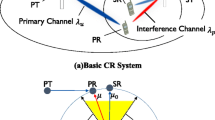Abstract
We propose a mechanism to form hole-like shapes with each of several sensor nodes equipped with a directional antenna called CS-DOA. In the system, we use an adaptive beamformer that can receive useful signals and adjust receiving angles through direction-of-arrival (DOA) estimations. We analyze single sources and links with sensor nodes to form a path around a given hole’s margins. This work’s proposed mechanism uses different receiving angles to detect a single source, and through the source message, we can detect and determine the given hole’s margins. We use cognitive radio to estimate the energy of sensor nodes. We also propose energy consumption control via a game scheme to prolong sensor nodes’ lifetime. This innovative mechanism increases performance and convenience, and improves our ability to make rigorous calculations regarding environmental topography.
Similar content being viewed by others
References
Li Minglu, Ding Ling, Shao Yifeng, Zhang Zhensheng, Li Bo (2010) On reducing broadcast transmission cost and redundancy in ad hoc wireless networks using directional antennas. IEEE Transactions on Vehicular Technology 59(3): 1433–1442
Rong P., Sichitiu M. (2006) Angle of arrival localization for wireless sensor networks. 3rd Annual IEEE Communications Society on SECON 1: 374–382
Cartigny J., Simplot-Ryl D., Stojmenovic I. (2004) An adaptive localized scheme for energy-efficient broadcasting in ad hoc networks with directional antennas. PWC, Lecture Notes in Computer Science 3260: 399–413
Ramanathan R., Redi J., Santivanez C., Wiggins D., Polit S. (2005) Ad hoc networking with directional antennas: A complete system solution. IEEE Journal on Selected Areas in Communications 23(3): 496–506
Chunyu H., Yifei H., Hou J. (2003) On mitigating the broadcast storm problem with directional antennas. IEEE International Conference on Communications, ICC, 1: 104–110
Shen C.-C., Huang Z., Jaikaeo C. (2006) Directional broadcast for mobile ad hoc networks with percolation theory. IEEE Transactions on Mobile Computing 5(4): 317–332
Lim H., Kim C. (2000) Multicast tree construction and flooding in wireless ad hoc networks. ACM MSWiM 1: 61–68
Lou W., Wu J. (2002) On reducing broadcast redundancy in ad hoc wireless networks. IEEE Transactions on Mobile Computing 1(2): 111–122
Peng W., Lu X. (2001) AHBP: An efficient broadcast protocol for mobile ad hoc networks. Journal of Computer Science and Technology 16(2): 114–125
Zhao F., Guibas L. (2004) Wireless sensor networks: An information processing approach. Elsevier, Amsterdam
Karl H., Willig A. (2005) Protocols and architectures for wireless sensor networks. Wiley, New York, NY
Bulusu N., Heidemann J., Estrin D. (2000) GPS-less low cost outdoor localization for very small devices. IEEE Personal Communications on Magazine 7(5): 28–34
Carus A., Urpi A., Chessa S., De S. (2005) GPS-free coordinate assignment and routing in wireless sensor networks. 24th IEEE Computer Communications Societies (INFOCOM) 1: 150–160
Li, J., Jannotti, J., De Couto, D., Karger, D., & Morris, R. (2000). A scalable location service for geographic ad-hoc routing. In Proceedings of Mobicom.
Rao, A., Papadimitriou, C., Shenker, S., & Stoica, I. (2003). Geographic routing without location information. In Proceedings of Mobicom.
Fonseca R., Ratnasamy S., Culler D., Shenker S., Stoica I. (2004) Beacon vector routing: Scalable point-to-point in wireless sensornets. Intel Research, IRB-TR-04 12: 2–15
Karp, B., & Kung, H.T. (2000). GPSR: greedy perimeter stateless routing for wireless networks. In Proceedings of ACM MobiCom, (pp. 243–254).
Yu, Y., Estrin, D., & Govindan, R. (2001). Geographical and energy-aware routing: A recursive data dissemination protocol for wireless sensor networks. UCLA Computer Science Department Technical Report, Los Angeles: University of California, (pp. 1–11).
Yu, F., Choi, Y., Park, S., Lee, E., Tian, Y., & Kim, S. (2007). An edge nodes energy efficient hole modeling in wireless sensor networks. IEEE Global Telecommunications Conference (GLOBECOM), (pp. 4724–4728).
Poor H.V. (1994) An introduction to signal detection and estimation (2nd ed.). Springer, Berlin, Germany
Filar J.A., Vrieze K. (1997) Competitive Markov decision processes. Springer, New York, NY
Author information
Authors and Affiliations
Corresponding author
Rights and permissions
About this article
Cite this article
Cheng, ST., Horng, GJ. & Wang, CH. Using Direction of Arrival to Estimate Obstacle Areas in Cognitive Sensor Environments. Wireless Pers Commun 69, 269–284 (2013). https://doi.org/10.1007/s11277-012-0572-z
Published:
Issue Date:
DOI: https://doi.org/10.1007/s11277-012-0572-z




